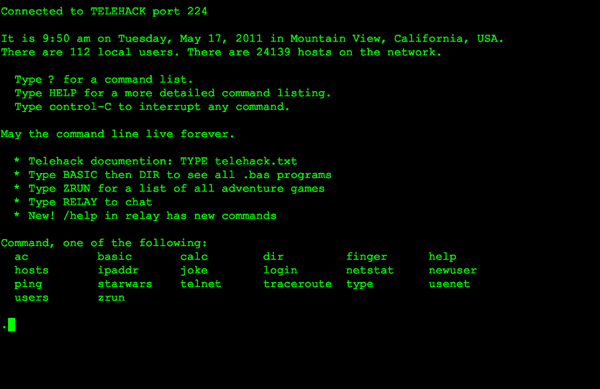Once a upon a time, before Tim Berners-Lee hatched the idea for the World Wide Web at CERN, the Internet was completely text-based.
If you were lucky enough to have Internet access in the late ’80s and early ’90s, it was a sure bet that you had to have at least some skill using the command line. You either had an account through a university or large corporation, or a dial-up account with one of the providers that were popping up all around as the Internet slowly grew in popularity.
Someone has created an amazingly faithful recreation of the Internet’s original text-only roots, drawing on materials from Jason Scott’s popular Textfiles.com (a collection of, you guessed it, text files from the classic BBS era). Scott is alsp documentary filmmaker, and owner of Twitter’s favorite cat, Sockington.
When you visit Telehack.com, you’ll be greeted with what looks like an old command-line interface, simulating an old green screen monochrome monitor. You can also telnet into Telehack as well. It might actually be a good idea, since the Web interface is rather slow.
You can sign up for an account and log in. The commands are loosely based on MS-DOS, though some Unix commands will also work. There’s a BASIC interpreter so you can run the classic 20 GOTO 10 program, and there are lots of other programs available. You can also play thouands of text adventure games, including “Zork.”
If that’s not enough, there’s an extensive archive of Usenet posts from the classic era.
The real fun starts when you venture out into Telehacks recreation of thousands of real hosts from the pre-Web Internet. You can “hack” into these sites and explore the various text files and run additional programs. If you’re at all familiar with Textfiles.com, you’ll know that the files are…interesting. As you progress, you’ll also get access to additional hacking tools. You might, for example, be able to rootkit systems. (Don’t worry, authority figures, it’s only a simulation!)
Telehack is a great way for those who grew up after the Web to see how old fogies used the Internet. For more retro fun, see our post on a graphical interface from 1982 and The Internet in 1998.
Via: Slashdot /Telehack.com











